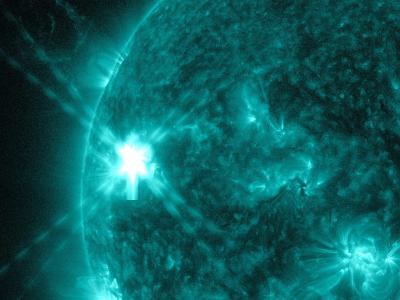The sun emitted a mid-level solar flare, peaking at 12:20 p.m. EDT on July 8, 2014, and NASA's Solar Dynamics Observatory captured images of the event. Solar flares are powerful bursts of radiation. Harmful radiation from a flare cannot pass through Earth's atmosphere to physically affect humans on the ground, however -- when intense enough -- they can disturb the atmosphere in the layer where GPS and communications signals travel.
To see how this event may affect Earth, please visit NOAA's Space Weather Prediction Center at http://spaceweather.gov, the U.S. government's official source for space weather forecasts, alerts, watches and warnings.
This flare is classified as an M6.5-class flare.

A mid-level flare erupted on the left side of the sun on July 8, 2014. This image from NASA's Solar Dynamics Observatory highlights light of 171 Angstroms, which highlights the hot temperature of solar material in a flare and which is typically colorized in teal.
(Photo Credit: NASA/SDO)
Updates will be provided as they are available on the flare and whether there was an associated coronal mass ejection or CME, another solar phenomenon that can send solar particles into space and affect electronic systems in satellites and on Earth.
Source: NASA/Goddard Space Flight Center